Branch Technology leverages technology to enable design freedom
Platt Boyd wants to 3D print your next house. And by early next year, he hopes to have a real-life example to show you, in Chattanooga, Tenn.

Meantime, Branch Technology Inc., the company he founded there a little over three years ago, continues to take on challenging new projects that stretch the capabilities of Branch’s patented 3D printing technology, dubbed Cellular Fabrication™, or C-Fab™.
Boyd, an architect by training, headed a small group of architects and engineers who started Branch with a vision “to liberate design” using their C-Fab production process, which combines 3D printing, industrial robotics, sophisticated algorithms, and carbon composite materials to free-form print open‐cell structures to enable a new, more sustainable way to build.
All about Cellular Fabrication
The technology is distinctive, Boyd explains, in that it prints volumes as cellular matrices. The open‐cell nature allows for efficient builds and dimensional forms restricted only by your imagination. Using this process, material can be solidified in mid‐air to create open‐matrix structures capable of taking on virtually any form. For architectural application, the matrix acts as a formwork or scaffold to accept traditional building materials.
C‐Fab uses a patented extrusion head attached to a Kuka Robotics arm. The arm travels along a horizontal track creating a build volume of 3,000 cubic feet. The company says that specially-developed algorithms allow it to translate virtually any three‐dimensional design into physical form. C‐Fab creates full‐ scale building components, not models, Branch stresses.
The process is capable of generating components that are 8 feet wide by 12 feet high by 40 feet long. Each component can be attached to the next, allowing even larger builds and continuous forms of unprecedented scale.
In 2015, shortly after the firm’s founding, Branch conceived the Freeform Home Design Challenge to invite architects, designers, engineers and artists from around the world to participate in an investigation of how 3D printing technologies can improve our built environment and lives today.
3D printing an entire house
Branch received 1,333 entries from 97 countries, and it shared the top 50 submissions for online voting. A five-person judging panel selected the ultimate winner –– submitted by WATG Urban Architecture Studio in Chicago –– and its design, called “Curve Appeal.” Branch committed to building the single-story, one-bedroom, one-bathroom house with a 1,000-square-foot open floor plan, outdoor patio and car port, on the campus of Chattanooga State College.
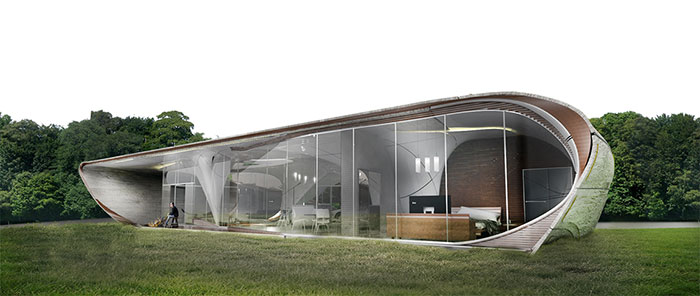
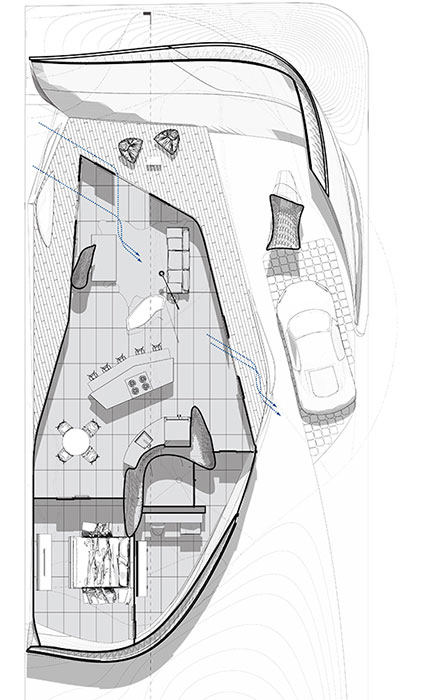
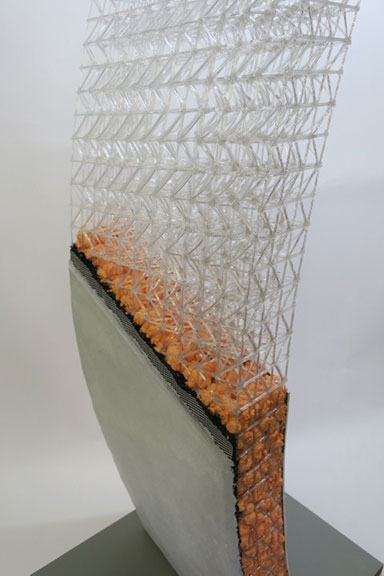
The architecture consists of multiple composite panels of varying sizes making up the exterior building envelope, interior partitions, structural columns and furniture elements. Composite panels will use Branch’s C-Fab matrix internal structural lattice.
The exterior cladding is made of glass-fiber-reinforced concrete; the internal matrix lattice of carbon-fiber-reinforced ABS; the matrix in fill of closed-cell polyurethane foam; and the interior surfaces of various gypsum-based products.
Branch says the composite construction will provide between three to four times the strength of traditional wood stud construction, will have a projected insulation (or “R” value) as high as 50, and yield a net zero energy structure.
While they won’t hit their initial target date for starting the installation in the third quarter of this year, Branch director of development David Feuhrer said recently they are now aiming for mid-2019.
Potential C-Fab construction benefits
Branch claims its C-Fab method for will allow for constructing custom, prefabricated building components with improved materials strength, lower construction and labor costs and increased energy efficiency.
In addition to liberating the design process, Branch suggests another key benefit to C‐Fab is that it is an inherently zero‐waste process. While the construction and demolition industry produce about 30 percent of all waste, the C‐Fab method constrains material use to only that which is absolutely required.
The process also delivers job‐site efficiencies, the company notes. The U.S. construction industry wastes an estimated $73 billion in labor each year because of inefficient on‐site fabrication techniques. By shipping modular components to the job site, it claims, contractors can realize an assembly process that is as much as 30 percent faster and 1.7 times more labor efficient than typical, on‐site methods.
Printing Nashville’s One City band shell
Meantime, while the Curve Appeal house is Branch’s centerpiece project, it is keeping plenty busy with other tasks, as well. In the latest example of collaboration between Branch Technology and Clinton, Tenn.-based compounder and materials design firm Techmer PM LLC, the partners completed a pair of high-profile projects –– an outdoor band shell in Nashville, Tenn., and an indoor hanging garden installation at Chicago’s Field Museum.
The band shell –– called One City –– measures 42 feet in diameter and more than 19 feet tall, making it the largest free‐form, 3D‐printed structure in North America. Branch says One City also boasts its longest unsupported span of 42 feet, creating strength through optimized geometry, without the need for structural steel.
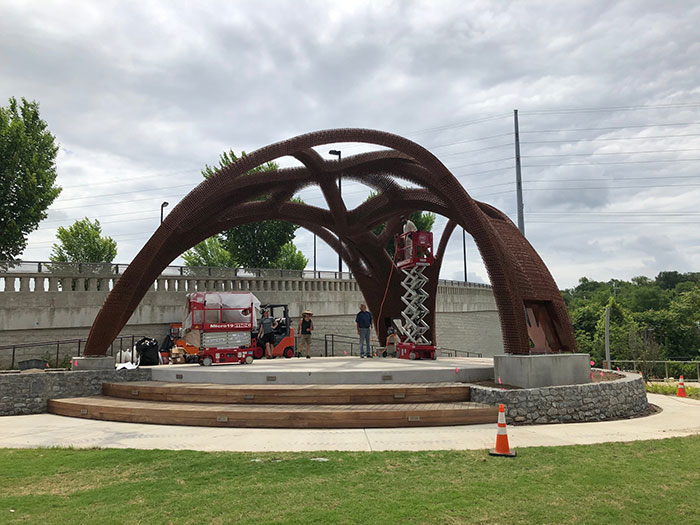
Consisting of 36 smaller parts, the largest individual component measures more than 18 feet long and fills a volume of 61.5 cubic feet. Branch used Techmer PM’s Electrafil® carbon‐fiber‐reinforced engineering plastics for the band shell.
Hanging gardens for Chicago’s Field Museum
In Chicago, meanwhile, Branch created the world’s first and largest free‐form, 3D‐printed hanging garden installation –– called “Nature Clouds” –– for the Chicago Field Museum of Natural History, to help celebrate the museum’s 125th anniversary.
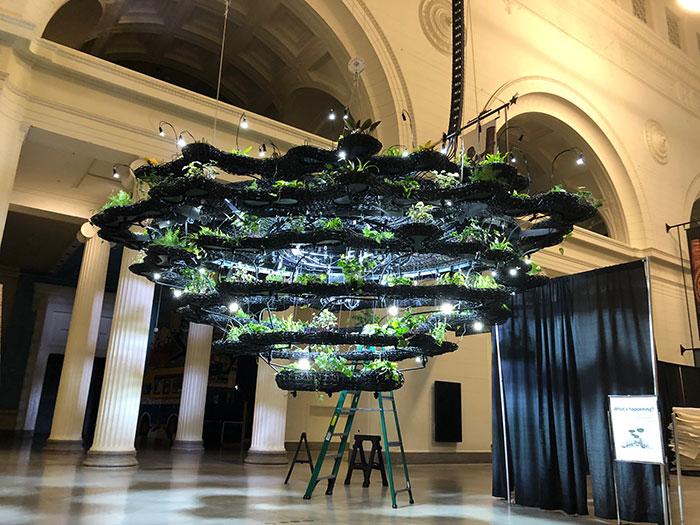
Installed in the museum’s Stanley Field Hall, the “clouds” are part of a larger environment that includes several life‐size dinosaur installations. The four hanging gardens, or clouds, comprise 3,940 pounds of printed material and steel, and supports vegetation, hydroponics, lighting, theatrical fog and sound equipment with a combined weight of 12,270 pounds. Each cloud can be raised or lowered as needed.
The largest cloud also provides an immersive plant environment when lowered for public interaction. Branch created the 3D printed parts on the world’s largest freeform 3D printing robots using a biopolymer specially formulated by Techmer PM as the printing material.
The project’s designer, Daniel Pouzet, and the museum’s exhibits group chose Branch’s C‐Fab method to leverage the technology’s strength, light weight, design freedom, and cost effectiveness compared with traditional steel construction. The project’s total printed volume amounts to 756 cubic feet, comprising 279 total parts, according to Branch.
“Typical construction methods are constraining,” notes Boyd. “Custom complex form is prohibitively expensive and often inconceivable to manufacture. With our C‐Fab process, cost‐effective design freedom is democratized for all.”
To learn more, go to www.branch.technology or www.techmerpm.com.
Looking for 3D printing materials to design your own masterpiece?
UL Prospector® offers a robust material search engine with thousands of product listings, with technical data and comparison tools right at your fingertips. Find out what Prospector can do for you today!
Register for Prospector
Hand-picked related content:
- 3D Printing – A Convergence Between Printer Makers and Polymer Manufacturers
- Innovations Restore Industrial 3D Printing to the Limelight
- Multi-material 4D Printing with Tailorable Shape Memory Polymers
- Advancing Composites – Adding Carbon Fiber to the Designer’s Palette
The views, opinions and technical analyses presented here are those of the author or advertiser, and are not necessarily those of ULProspector.com or UL Solutions. The appearance of this content in the UL Prospector Knowledge Center does not constitute an endorsement by UL Solutions or its affiliates.
All content is subject to copyright and may not be reproduced without prior authorization from UL Solutions or the content author.
The content has been made available for informational and educational purposes only. While the editors of this site may verify the accuracy of its content from time to time, we assume no responsibility for errors made by the author, editorial staff or any other contributor.
UL Solutions does not make any representations or warranties with respect to the accuracy, applicability, fitness or completeness of the content. UL Solutions does not warrant the performance, effectiveness or applicability of sites listed or linked to in any content.



Awesome! Great piece of information is shared in detail.
Thanks a lot for sharing this post and brilliant site you have very thankful all.First Look 3D Studio denotes exactly what we do. We are a 3D architectural visualization company that uses the latest advancements in technology and the most creative and artistic minds to help you visualize and showcase your real estate ventures to your family, investors, clients and the rest of the world.Our driving force is our passion to provide our clients the best creative and technologically advanced solutions to their needs and ensure that their requirements are fulfilled.The smiles of our customers, the looks of disbelief we get when they see our finished product and the appreciation we gain at the end of it all is what drives us to excel and innovate in our work day after day!
Hey! The open‐cell nature allows for efficient builds and dimensional forms restricted only by your imagination.
Thanks for your comment. Yes, I have visited Branch’s new HQ in Knoxville, and it’s amazing what they are capable of printing.
Best regards,
Bob
Thanks for sharing the tips. I am using this to make others understand.
Thanks for sharing the tips. I am using this to make others understand